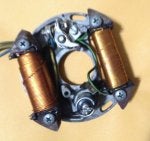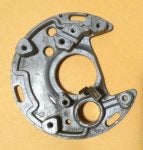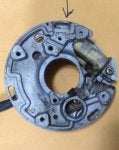Well - I know you are smarter than an 8th grader- but just in case, lets do 1st grade pictures
Below are the RM stator parts -
They are NOT the same design as Nipondenso. They are NOT the aftermarket clone replacements you suggest (SPI etc).
FIRST
The CDI box and the external spark plug coil are not separate units - they are one piece.
You can't do what you suggest.......
You have a Single CDI Plug that comes off the Stator that plugs into one side of the CDI BOX, that other Cable off CDI Box plugs into either a Single Firing Coil for Singles or a Dual Firing Coil for Twins. IF you want Dual Plugs for a Single, just use the Twin Dual Firing Coil..
Please tell us how YOU would do a two spark plug arrangement with the RMstator design.
==> First this Thread is about Converting Rotax Singles, not Twins. As you said, different Engines have different Timing Requirements, that's WHY I said Slots would have been a better Choice to use, since that would allow it to be used on more Engines. When I first stumbled on this CDI Conversion many years ago now, they were using a different CDI Box Setup, they have stopped Production and started it at lest twice that I know of, and Yes, looking at their current CDI Box in your photo, that is a Combo CDI/Coil Single Firing Unit of unknown origin, it looks to be off one of the newer ATV's or Scooters. But Yes, to Answer your Question, How to, for a Twin would be to either Swap the Combo Single Firing Unit out with same unknown Brand to us, with a Dual Firing Combo Unit, or use a WYE CABLE and use (2) of the unknown to us, Single Firing Combo Units. It fires at TDC and BDC, a Wasted Spark Ignition. Like I said, if you wanted Dual Plugs on a Single like Niko did on his 277, just use the Dual Firing Combo Unit. The Principal is the same Combo Unit COIL/CDI or seperate CDI Box and Coil. I prefer the Separate Setup, first because there cheaper, 2nd if you lose one or the other it's also cheaper to replace. <==
SECOND
The trigger coil on the RMStator is NOT two coils like a Nippondenso - high speed and low speed. It is a single coil. That indicates a much different timing curve is probably used.
Example - Points usually run about 25 degrees when fully advanced -the Nippondenso CDI runs about 19 degrees.
What full advance did RMstator use? 25 like the points stator it was replacing or 19 like a normal Nippon CDI?
More important what would you want YOUR engine to be?
THEREFORE
To my original point - You can't ASSUME that a true Nippondenso/Rotax stator can be positioned exactly the same as an RMstator unit.
==> First, RMstator doesn't sell the individual kit parts to build your own kit, so IF, your going to do something similar, your going to use what I said was the easiest to use, the Nippon Denso CDI setup that was made for Rotax 277, 377, 440, 503's! The one thing that is a Constant, is the Stator, it's SIZE, and LOCATION of the CDI COIls doesn't change! Those STATOR COILS have to be in the RIGHT POSITION with those (4) MAGNETS on the FLYWHEEL to FIRE. With Slots, you can Rotate the Plate +/- a few Degrees. IF, this works on the 247/250 Singles which show different Timing but real Close, they probably picked the middle of them. The 247 (0.147-0.167 in.) and 250 (0.150-0.170 in.) so with a Variance Range of 0.147" to .170" middle of the road would be 0.0115" .
IF, TDC = 0 Degrees, You ought to be able to figure your STATOR PLATE Circumference, let's just say for Example I don't have it close by me, Diameter 8" x 3.14(PI) = 25.12"(Circumference) / 360 = 0.0697777777777778" per (1) Degree for this Example. So if Nippon Denso CDI is 16 Degrees it would be 16 x 0.0697777777777778" = 1.116444444444444" of ZERO Degrees. But if the Points are Keyed at 20 Degrees, I would think you would need to use the same. By using just a HOLE like they did, you have to be pretty precise on where you Drill that Hole. On all of these Rotax's you only have a .020" VARIANCE in TIMING. The NIPPON CDI STATOR PLATE HOLE SLOT is 15 Degrees which is close to 15mm WIDE SIDE to SIDE. The STUDS are 4mm OD, so you loose 2mm each side moving it Side to Side = 4mm off that 15mm to have 11 Degrees roughly to Play with, IF, you use a Slot vs using a Hole. You only have (1) CASE BOLT PATTERN that doesn't change and only (3) CASE STUDS to Locate the STATOR PLATE on that are Equally SPACED. In this case, it's based on a (36) Hole Bolt Bolt Pattern, which 360/36 = 10 Degrees between Stud Center Lines. For Clearance Reasons, to put the Nuts on the Studs you only have one way that works and that is in the UP POSITION as they did. IF, you made a new Stator Plate, it could be Positioned Down, since it Fires at both TDC & BDC. Is there more than one POSITION, YES. BUT, YOU only have (3) CASE STUDS to MOUNT THAT SATOR PLATE and SPACE on that STATOR PLATE to WORK with for the Nuts! Since your using a known Nippon Denso CDI System that Works, it's figuring out how to mount it so it FIRES at the CORRECT TIMING POSITION. Yes, Nippon Denso has (2) Ignition Curves, that's WHY they Idle better than Ducati which only has (1). Since almost NOBODY in the World has a Blizzard Single, and probably very few People today even have a TNT Single, the Majority of People on here have just a Standard 247, 292, 299/300, 318/320, 335 Single which I think the Points version is keyed at 20 Degrees for them. We are TALKING THOUSANDTHS of an INCH in movement for these different Singles Timing. This Nippon Denso Conversion has been done the Old Way by just Re-Indexing the Points Flywheel and using the Yellow CDI Coil many THOUSANDS of Times by the big Ultralight Dealers, so is proven. I think this New Way by just using the whole Horse Shoe Stator is a lot easier if doing your own setup.
You can't Machine a Precision Slot on a Radius without a Rotary Table or make a Special JIG. Does it have to be a Precision Milled Slot, probably not, but I don't like doing something half assed. Like I said, I didn't have a 247 to test it on at the time so I put it on the shelf till I get my Rotary Table. They said it didn't work on my 335 at the time I inquired. I do have a Used Horse Shoe Stator I got with a 583 parts motor, and I also bought a New one off eBay. Caltric Brand off eBay are cheap $39 for Seadoo's. you just have pick what Connectors you want to use.
The Drilling and Milling doesn't affect it from being used as originally designed. <==
IT HAS TO BE TESTED - and since you only have one to play with ... maybe you should try my test procedure before you start milling/drilling away.
I'm not an expert machinist like you- but I'm pretty sure that once the material is milled or drilled away - it's really hard to change your mind and put it back.
Just the humble opinion of an 8th grader......


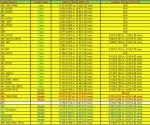



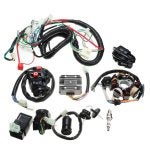



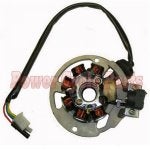





 )
)
